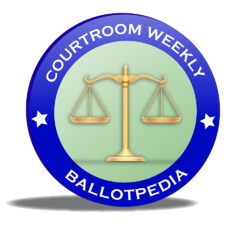by: the State Court Staff
Courts tackle traffic cameras, fertilizer, police liability and drug courts
|
|
|
Featured case
|
Judge stops NYC soda ban
Court: New York County Supreme Court, New York
|
|---|
| On March 11, 2013, Judge Milton Tingling, of the New York County Supreme Court, shot down a New York City soda ban supported by Mayor Bloomberg and the New York City Department of Health. The new law would have stopped restaurants and other such venues from selling sugary drinks larger than 16 ounces.
In his ruling, Tingling prohibited the city from "implementing or enforcing the new regulations" and turned the matter over to the New York State Legislature, stating that the Mayor and Department of Health did not have the authority to create such rules.[1]
Tingling wrote,
| “
|
The rule would not only violate the separation of powers doctrine, it would eviscerate it...Such an evisceration has the potential to be more troubling than sugar sweetened drinks.[1][2]
|
”
|
He also explained,
| “
|
It is arbitrary and capricious because it applies to some but not all food establishments in the city, it excludes other beverages that have significantly higher concentrations of sugar sweeteners and/or calories on suspect grounds, and the loopholes inherent in the rule, including but not limited to no limitations on refills, defeat and/or serve to gut the purpose of the rule.[1][2]
|
”
|
Michael A. Cardozo, a lawyer for the city, argued,
| “
|
We believe the judge was wrong in rejecting this important public health initiative. We also feel he took an unduly narrow view of the Board of Health's powers.[3][2]
|
”
|
The Appellate Division's First Department has already agreed to hear an appeal during the first week of June.[4]
To read the full decision, click here. |
|
|
News from California
|
Biosolids fertilizer gets the go-ahead from California court of appeal
Court: California Fifth District Court of Appeal
|
|---|
| Last week, the California Fifth District Court of Appeal upheld a superior court's ruling against Kern County Sludge Initiative Measure E. The measure is a 2006 ordinance that prevents the use of biosolids fertilizer in Kern County. The term Biosolids refers to recycled municipal sewage sludge that is sometimes used as agricultural fertilizer.[5]
The court found that the ban damages communities that use biosolids for farming and that biosolids are not detrimental to the inhabitants of Kern County.
| “
|
First and foremost, the superior court, in a determination not challenged by any party in this appeal, concluded there was no evidence at all of hardship to Kern County if the injunction were granted. The proponents of Measure E insisted that land application of biosolids is dangerous, but the record in this case so far does not support their view. At the same time, there is a substantial likelihood of harm, including irreparable harm, to plaintiffs if the preliminary injunction is not granted.[5] - In the written decision by the Fifth District Court of Appeal[2]
|
”
|
The Water Environment Federation (WEF) praised the ruling:
| “
|
WEF and its members spend significant time and resources to educate the public and local decision makers regarding the current science on the benefits of recycling biosolids to farmland. The opinion provides significant precedent in this regard.[6] - Amanda Waters, general counsel for the WEF[2]
|
”
|
|
|
|
News from Oklahoma
|
Oklahoma court says jails liable for damages when excessive force used
Court: Oklahoma Supreme Court
|
|---|
| On March 8, the Oklahoma Supreme Court handed down an unusual ruling. Despite the strict immunity afforded by the state legislature under the Oklahoma Governmental Tort Claims Act, the court held that people injured by excessive force while in police custody have a constitutional right to sue both the government run jails and the employees individually who used the force. The caveat to the ruling, however, is that the person cannot have been convicted of any crime.[7]
The ruling stems from a case out of Cherokee County, Oklahoma. Daniel Bosh was arrested for unpaid fines and taken to the county jail. While in custody, however, officers smashed Bosh's head against a counter and he fell to the floor, landing on his head. Bosh was handcuffed during the incident, which was captured on the jail's security cameras. The officers claim Bosh was not cooperating and attempted to spit on at least one of them. Bosh sustained severe and persisting injuries in the incident, including shattered vertebrae; he must now use a cane and has constant pain.
Bosh filed suit against the jail and the police officers individually in 2011 but the Tort Claims Act barred his suit. With the Oklahoma Supreme Court's ruling, however, Bosh will now be able to push his suit forward, as will others who filed similar claims after his. The holding is retroactive but only applies to suits filed after Bosh filed his.
State officials worry that this ruling will open the floodgates of litigation in the future. Some fear those merely dissatisfied with their custodial experience will sue the "deep pocket" of the government. Successful suits could cost the state or county considerably. Though the jails carry insurance for such reasons, the government entities which operate the jails may be forced to increase coverage amounts for potential payouts on claims made by prisoners. Additionally, any payout by the insurance provider on behalf of the jail will likely cause a rise in premiums for the policy. Both would cause an increase in funding needs for the jails which means more tax dollars being channeled away from other areas and put into jail budgets. |
|
|
News from Florida
|
Appellate Court approves red-light cameras
Court: Florida Fourth District Court of Appeal
|
|---|
| The Florida Fourth District Court of Appeal dismissed a case last week that challenged the constitutionality of red-light cameras in the state. The appellate court upheld a lower court's decision in the case of Salvatore Altimari vs. the State of Florida and the City of West Palm Beach. The ruling means that red-light cameras are likely to stay.[8]
Salvatore Altimari received a ticket for running a red-light in the City of West Palm Beach. He then brought a challenge to the Mark Wandall Traffic Safety Act to the 15th Circuit Court. The act was made law in 2010 and is named after a man who was killed by a red-light runner. The court rejected Altimari's arguments on February 27.[8]
George Hittner, general counsel for American Traffic Solutions, stated,
| “
|
It is time traffic-ticket attorneys stop giving their clients false hope that they will not be held accountable and, instead, encourage them to stop running red lights and jeopardizing the lives of others on the roadways.[8][2]
|
”
|
Some residents are not so convinced that the cameras are a good idea. However, they have already been implemented in over 50 counties and cities across Florida. Nationwide, 21 states permit some type of red-light cameras, while 9 states prohibit them. The other 20 states have yet to establish laws for the enforcement of such cameras.[8] |
|
|
News from West Virginia
|
West Virginia Supreme Court justice supports drug courts
Court: West Virginia Supreme Court
|
|---|
| West Virginia Supreme Court Chief Justice Brent Benjamin testified in front of the state legislature on the success of drug courts in light of pending legislation concerning the state's prison and court system.[9] On February 26th, Benjamin praised the success of the drug court system in the state, noting that it not only decreased rates of recidivism, but also was much less financially burdensome than the traditional court system.[9] There are currently 36 drug courts in the state, 16 of which are juvenile courts.
According to Benjamin, a report conducted by the state Supreme Court shows a dramatic difference in recidivism rates between drug court participants and criminals in the traditional justice system. In adult drug courts, which were founded in 2003, 52 percent of participants graduated from the program. Since 2007, the year juvenile drug courts were formed, 62 percent of juvenile participants have graduated from the program.[9] Nearly 10 percent of adult drug court graduates will return to jail sometime after the programs completion, the juvenile rate is 14%. However, the rate of recidivism for offenders in the traditional court system is 30 percent for adults and 51 percent for juveniles, a significant difference.[9][10]
Benjamin also reported on the savings for the state offered by drug courts.[10][9] It costs about $7,100 a year to place an individual in drug court. Meanwhile, it would cost more than $18,000 to place that person in jail and $24,000 to keep them in a state prison. The savings are even greater for juvenile drug courts. In that system, $6,400 funds eight months of assessment and outpatient care and supervision; however, eight months in a juvenile detention facility costs $96,000. The treatment offered by drug courts also costs well below what some residential drug treatment facilities charge, which can be as much as $99,000 for six months.[9] Circuit court judge Phillip M. Stowers has also voiced his support for the program, noting the savings in his own Putnam County.[10]
Two weeks after Benjamin's testimony, the legislature is still struggling to get a final bill on prison and court reform to the floor for a vote, but Governor Earl Ray Tomblin has continued to talk about the issue and pledge money to the cause. The current state of the bill would shift the jail costs from drug courts from the counties to the state, and allow judges more choice in sentencing individuals to, "...evidence-based models of treatment."[11] Aside from drug courts, the legislation would offer judges more flexible sentencing guidelines. |
|
|
See also
- ↑ 1.0 1.1 1.2 New York Post, "Judge halts mayor's soda ban, calls it 'arbitrary and capricious'," March 11, 2013
- ↑ 2.0 2.1 2.2 2.3 2.4 2.5 Note: This text is quoted verbatim from the original source. Any inconsistencies are attributable to the original source.
- ↑ Newsday, "NYC soda ban: Bloomberg to challenge judge's ruling," March 13, 2013
- ↑ Reuters, "New York City's appeal of soda ban ruling to be heard in June," March 13, 2013
- ↑ 5.0 5.1 City of Los Angeles v. County of Kern Decision
- ↑ Waste 360, "California Court Upholds Biosolids Recycling Ruling," March 13, 2013
- ↑ Court: people can sue jails for use of excessive force, Fox23.com, March 8, 2013
- ↑ 8.0 8.1 8.2 8.3 Bloomingdale-Riverview Patch, "Court Ruling May Mean Red-Light Cameras Are Here to Stay," March 7, 2013
- ↑ 9.0 9.1 9.2 9.3 9.4 9.5 Charleston Daily Mail, "Justice Benjamin touts WV progress with drug courts," February 26, 2013
- ↑ 10.0 10.1 10.2 WOWKTV, "Could drug courts be a solution to drug abuse?" March 7, 2013
- ↑ The Spirit of Jefferson and Farmer's Advocate, "Jails, drugs still the focus," March 13, 2013








